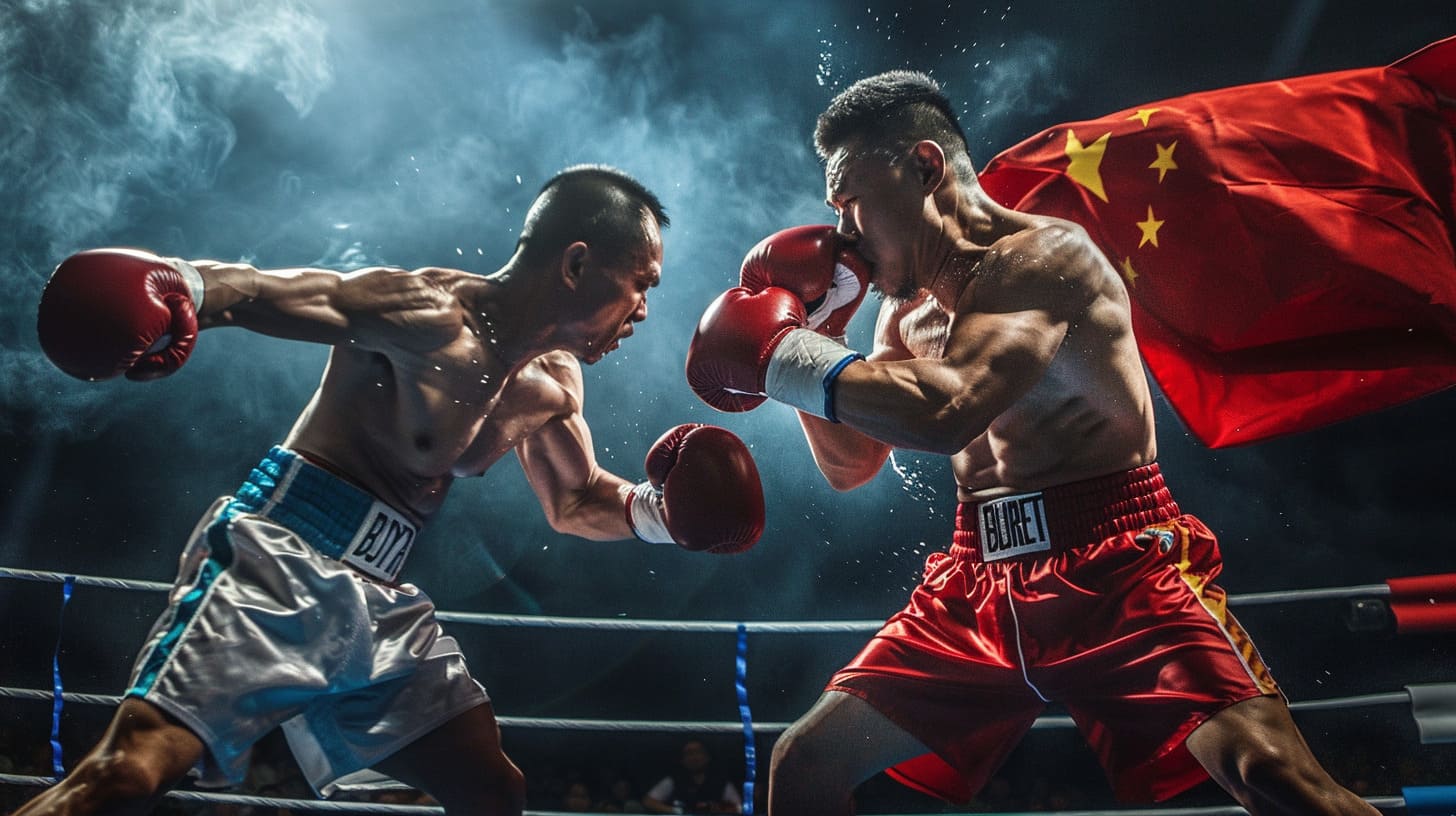Chinese boxing styles, with their deep roots in martial arts philosophy and practical self-defense, offer a fascinating blend of ancient tradition and dynamic combat techniques. From the fluid movements of Tai Chi to the explosive power of Sanda, Chinese martial arts encompass a variety of styles, each with its own unique strategies and philosophies. Whether you’re a seasoned martial artist or just intrigued by the cultural heritage of China’s fighting systems, there’s a wealth of knowledge to discover about these elegant and effective forms of boxing.
What Is Chinese Boxing Style?
When you think of martial arts, your mind might immediately take you to a place of discipline, tradition, and a variety of unique fighting styles. Chinese boxing, also known as Chinese martial arts or Kung Fu, embodies all these elements with a rich history to boot. So, let’s untangle this intricate form of combat and understand its fundamental attributes.
Core Principles and Techniques
Chinese boxing isn’t just a physical activity; it’s deeply interwoven with Chinese philosophy and medicine. Its techniques encompass more than just punches and kicks; it integrates mental focus, precise control, and an understanding of the flow of energy within the body.
- Harmony of Body and Mind: Striking a balance between physical action and mental focus is key in Chinese boxing. Practitioners must be fully present in every movement.
- Qi (Energy) Flow: Techniques are designed to enhance and control the flow of Qi within the body, believed to be vital for health and effective martial application.
- Five Elements Theory: Some Chinese boxing styles incorporate strategies based on the traditional Chinese belief in the five elements (wood, fire, earth, metal, water) and their interrelationships.
Stance, Footwork, and Guard
The boxer’s stance is less about aggression and more about stability and preparedness. Here’s what you can typically expect:
- Stance: Rooted yet flexible, typically wider and lower than conventional boxing stances, allowing for quick directional changes.
- Footwork: Circular and evasive moves are common, emphasizing the ability to flow around an opponent rather than just towards or away.
- Guard: The guard positions can vary widely but often involve protecting the centerline of the body. Some styles utilize high guards with hands up, while others focus on deflective movements to ward off attacks.
Distinguishing Factors
The elegance of Chinese boxing can be as mesmerizing as it is effective. Distinguished from conventional western boxing, several elements stand out:
- Integration of Kicks and Open-Hand Techniques: Where western boxing focuses on punches with closed fists, Chinese boxing incorporates a range of open-hand strikes and powerful kicking techniques.
- Use of Leverage and Throws: Chinese boxing often involves joint locks and throws, using an opponent’s force against them.
- Defensive and Counterattacking: This isn’t just about hitting; it’s about simultaneous blocking and striking, making defense a critical component of the offense.
In a nutshell, Chinese boxing is a profoundly complex yet beautiful art form that goes beyond the simple goal of landing punches. It’s about understanding oneself, mastering energy flow, and engaging with opponents with a strategic layer that’s as thoughtful as it is physical. Perfect for those looking to embrace tradition and deepen their martial arts knowledge, Chinese boxing offers a journey as exciting as its techniques.
Signature Moves & Strategies in Chinese Boxing Style
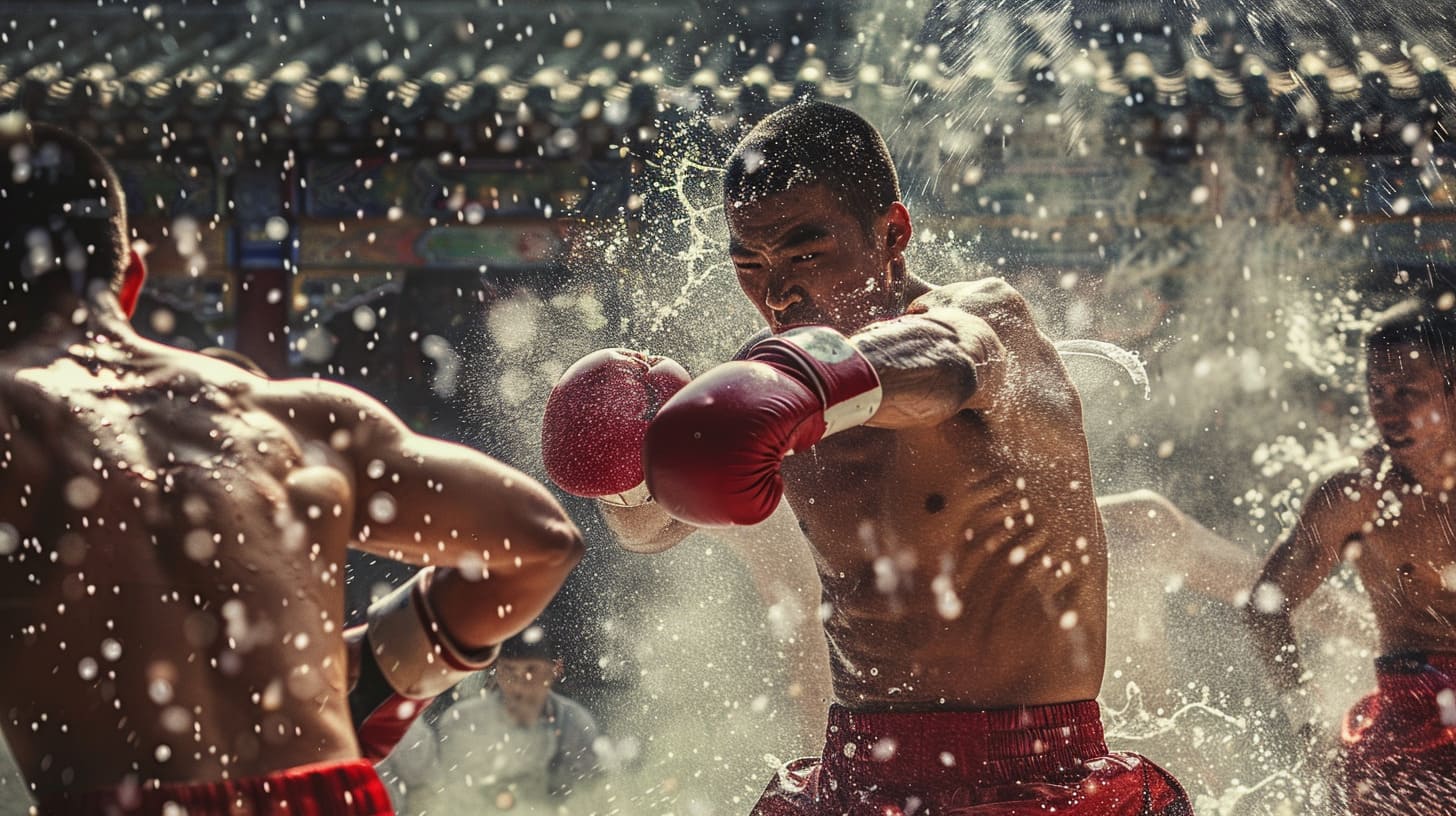
Ever wondered what makes Chinese boxing so unique? It’s all in their signature moves and strategies that have been honed over centuries. Here, we’ll dive into the three most pivotal techniques that define the art of Chinese boxing, showcasing how these moves not only demonstrate skill and finesse but also contribute to the martial art’s striking effectiveness.
1. The Eight Trigrams Palm
The Eight Trigrams Palm, also known as Baguazhang, is not just a technique but a philosophy woven into movement. It emphasizes circular footwork and agile movements, resembling the dance of a dragon – fluid yet potent.
- Circular Footwork: Allows for evasion and attack from multiple angles.
- Continuous Motion: Helps maintain momentum and confuses the opponent.
- Palm Strikes: Delivered from unpredictable directions for effective strikes.
Legend has it that Dong Haichuan, the founder of Baguazhang, could fend off multiple attackers with ease using these principles. His flowing movements and sudden strikes were like a gust of wind that one could feel but could hardly grasp.
2. The Five Animal Forms
The essence of Chinese boxing can be witnessed in the Five Animal Forms, which mimic the movements of the Crane, Tiger, Leopard, Snake, and Dragon. Each form brings unique strategies to the fighter’s arsenal.
- Crane Form: Teaches balance and precision. The Crane is known for its poise and its ability to strike with pinpoint accuracy.
- Tiger Form: Encourages power and ferocity. The sheer strength of a Tiger Form practitioner can be overwhelming for any opponent.
- Leopard Form: Focuses on speed and explosive power, ideal for quick and decisive strikes.
- Snake Form: Hones on flexibility and deceptive striking. Like a snake’s unanticipated bite, a fighter can catch an adversary off guard.
- Dragon Form: Cultivates spirit and dynamic energy flow, making the fighter’s moves both graceful and potent.
Icons like Bruce Lee, who famously incorporated the fluid movements of the Dragon and the explosive power of the Tiger, have showcased the effectiveness of these animal forms in real combat situations.
3. The Iron Shirt
Lastly, we have the Iron Shirt technique, a traditional Kung Fu practice aimed at making the body capable of withstanding powerful blows. This method combines breathing techniques, Qigong exercises, and internal energy work.
- Qigong Breathing: Teaches practitioners to harness their internal energy, known as Qi, to reinforce body resilience.
- Body Conditioning: Involves repeated strikes to the body during training to increase its tolerance to hits.
- Energy Focus: Practitioners learn to focus their Qi into parts of the body that are struck, thereby reducing pain and injury.
Folklore is filled with tales of masters like Yi Jin, who were said to have such command over their Iron Shirt abilities that they could take strikes from swords and spears without sustaining any injury, a testament to this awe-inspiring strategy.
By integrating these signature moves and strategies, Chinese boxing becomes not just a martial art, but a rich tapestry of culture, philosophy, and unmatched martial prowess. And while reading about them is fascinating, watching a master at work is truly captivating — it’s poetry in motion, with a hint of thunder.
Challenges and Limitations
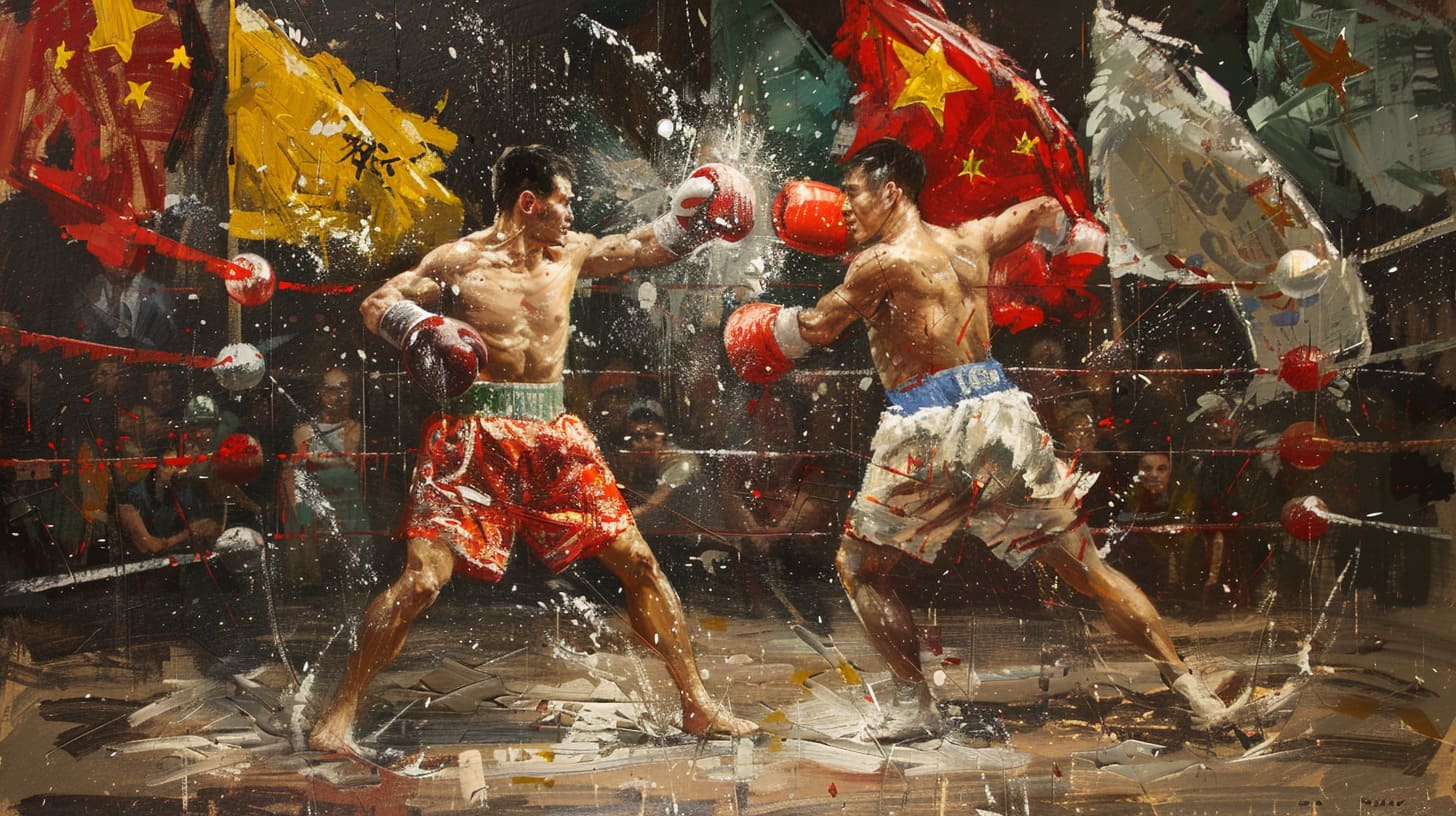
Let’s face it, every fighting style comes with its own set of challenges and limitations, and Chinese boxing is no exception. We’re going to dig into what might hold back a practitioner of this ancient and respected martial art—because being forewarned is being forearmed, right?
The Benefits of the Chinese Boxing Style
Now, let’s lace up and step into the ring of knowledge to understand where Chinese boxing really shines. Its techniques and principles have their roots deep in a rich martial arts history, and they offer some undeniable benefits.
Here are a few situations where the Chinese boxing style can give you the upper hand:
- Defensive Maneuvers: Its emphasis on fluid movements can keep you one step ahead.
- Counter Attacks: Timing is key, and Chinese boxing teaches you to strike with precision when your opponent least expects it.
- Stamina and Endurance: The rigorous training enhances your staying power in the ring.
- Close-Quarters Combat: This style is great at close range, allowing you to control the distance.
- Psychological Edge: The ancient philosophies that underpin this style can provide you with a calm mind amidst the storm of combat.
The Drawbacks of Chinese Boxing Style
Just as there are two sides to every coin, Chinese boxing has its flip side when it comes to practical application in certain scenarios. It’s not about being pessimistic but about understanding the full picture.
Here’s a rundown of instances where Chinese boxing might not have you holding the championship belt:
- Range: When going up against fighters with a longer reach or those proficient in long-range strikes.
- Ground Game: This style isn’t known for its grappling, which can be a downside if you end up on the mat.
- Heavy Hitting: While Chinese boxing is agile, it may lack the raw power of some Western boxing styles.
- Predictability: An opponent familiar with the style could anticipate and counter your moves.
- Adaptability: In a rapidly evolving fight, the traditional stances and strikes might not always be the best response.
Every martial arts style, including Chinese boxing, has its unique characteristics. Acknowledging the strengths and the limitations allows practitioners to make the most informed decisions both inside and outside the ring. Whether it’s choosing the right style for your personal needs or understanding how to counter specific tactics, knowledge truly is power. Keep training, stay sharp, and remember that the best fighter is always learning.
Defending Against Chinese Boxing Style

Getting to grips with the Chinese boxing style can feel like you’re trying to solve a dynamic puzzle. It’s a style characterized by a blend of fluid movements, unique stances, and a mix of defensive and offensive techniques that can catch many traditional boxers off guard.
Understanding Chinese Boxing Defense Challenges
Before we dive into how to defend against this style, let’s quickly explore what makes it such a tough nut to crack. Chinese boxing, known to many as Kung Fu or Sanda, brings together a wide arsenal of techniques that can seem unpredictable due to their origins in various martial arts.
- Broad Range of Attacks: Practitioners incorporate punches, kicks, throws, and joint locks.
- Fluidity and Speed: They move seamlessly from one technique to another, making it hard to anticipate the next move.
- Deceptive Techniques: Often, attacks come from angles that one doesn’t usually encounter in traditional Western boxing.
Defending Like a Pro
Now, let’s put on our boxing gloves and look at how to effectively defend against this versatile style.
Stay on Your Toes
You’ll need to match the fluidity of Chinese boxing with your own mobility. This means:
- Footwork: Keep moving and avoid being a static target.
- Balance: Maintain a solid base to avoid being thrown off by sweeps or throws.
- Distance Control: Manage the gap between you and your opponent to minimize their striking opportunities.
Sharpen Your Reflexes
Reacting swiftly can save you from a flurry of techniques.
- Sparring: Regularly practice with a partner to improve reaction time.
- Drills: Engage in defensive drills that mimic the unpredictability of Chinese boxing attacks.
Incorporate Evasion Tactics
Sometimes the best defense is not to be there when the punch lands.
- Lean and Slip: Use your upper body to lean away from strikes.
- Duck and Weave: Keep your head moving to evade high kicks and swinging strikes.
Additional Practical Tips:
[Master the Block and Counter] One of the most effective defenses is to utilize a block-and-counter strategy. Train to:
- Immediate Response: After blocking, immediately respond with a counter-strike to take advantage of the brief opening.
[Enhance Your Clinch Game] Getting in close can nullify the range advantage often used in Chinese boxing.
- Control: Focus on controlling the opponent’s arms and body to reduce their mobility and ability to strike.
[Study Your Opponent] Understand the common attack patterns and movements in Chinese boxing.
- Preparation: Watch footage and learn the cues that signal an upcoming strike to better anticipate and defend against it.
Remember, like any martial art, defending against Chinese boxing requires patience, practice, and keen observation. By integrating these tips and continuously refining your strategy, you’ll become adept at handling this complex and rich fighting style. Keep your guard up, stay agile, and always be prepared to adapt – that’s your winning combo right there.
Notable Practitioners
When it comes to Chinese Boxing, a few legends stand out—masters who’ve carved their names into the annals of martial arts history. These practitioners didn’t just fight; they embodied the spirit and technique of Chinese Boxing, inspiring generations to come. Let’s dive into the lives of three such luminaries who’ve left an indelible mark on the world of martial arts.
1. Wang Lang: The Mantis Master
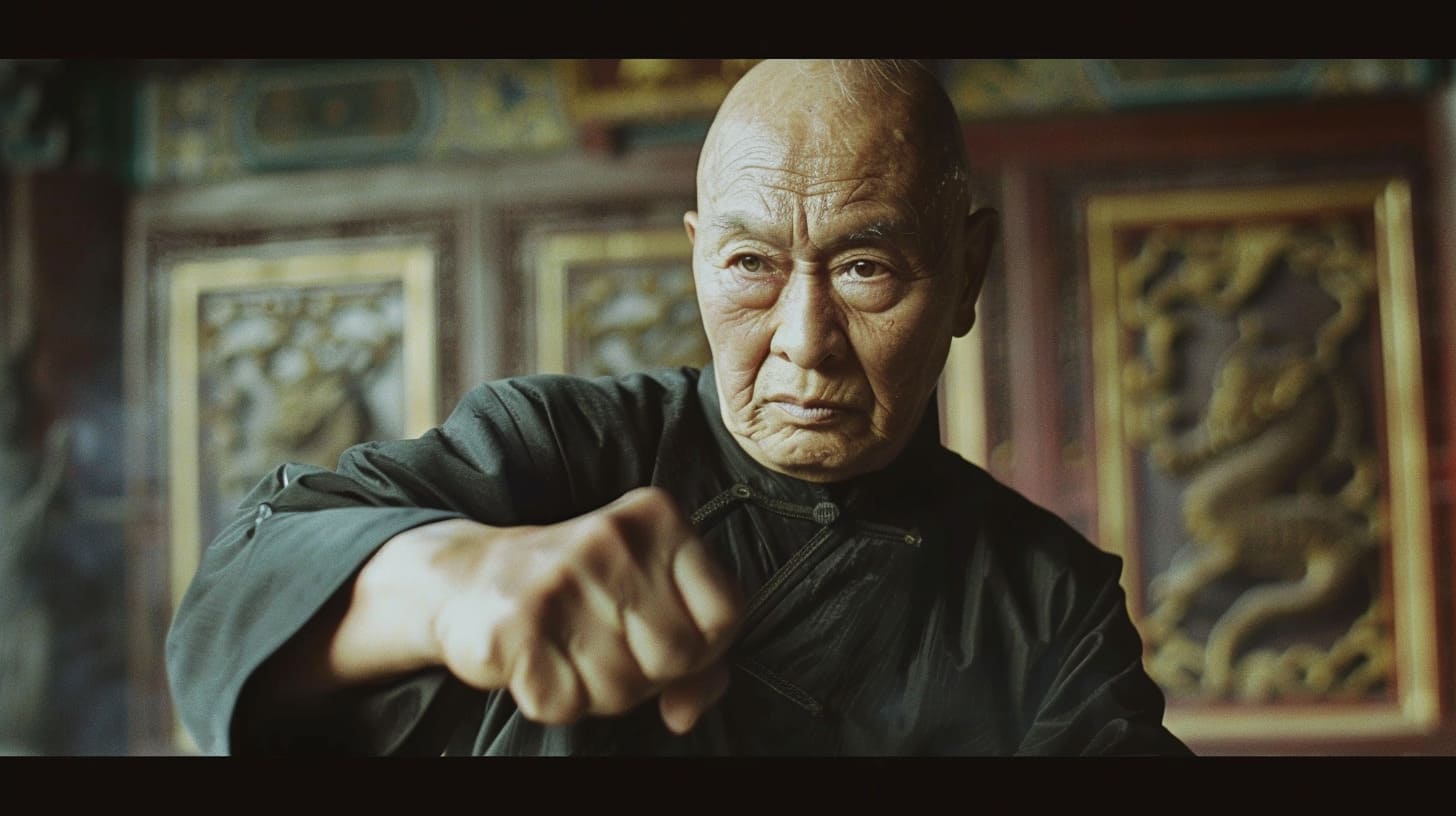
Wang Lang is often celebrated as a pioneer for his contribution to Chinese martial arts, particularly for the creation of Praying Mantis Boxing. His innovative style, inspired by the movements of the mantis, exhibits swift, angular attacks coupled with an emphasis on footwork and deception.
- Career Highlights:
- Founded Praying Mantis Boxing.
- Famed for integrating concepts from seventeen different martial arts styles.
- Memorable Moment:
- Legend has it that Wang Lang once defeated a group of bandits single-handedly using his distinctive mantis-style techniques, establishing his formidable reputation.
Through blending various martial arts elements, Wang Lang’s influence can be felt across numerous fighting systems that value adaptability and precision.
2. Huo Yuanjia: The Hero of the People

Huo Yuanjia’s story is one of resilience and national pride. Rising during a time when China faced foreign exploitation, Huo became a symbol of Chinese strength and spirit through his unmatched skill in Chinese Boxing.
- Career Highlights:
- Founder of the Chin Woo Athletic Association.
- Renowned for defending Chinese martial arts’ honor against foreign challengers.
- Memorable Fight:
- Huo’s most legendary bouts were those where he stood victorious against foreign fighters, using these opportunities to demonstrate the strength of Chinese martial arts to both China and the world.
Huo Yuanjia’s legacy is not just about his victories but also about his commitment to restoring China’s confidence through the art of Chinese Boxing.
3. Bruce Lee: The Dragon of Modern Kung Fu

Although Bruce Lee is commonly known for his association with Wing Chun and Jeet Kune Do, his foundation in Chinese Boxing is unmistakable. He modernized and globalized Chinese martial arts, influencing countless martial artists worldwide.
- Career Highlights:
- Introduced Chinese martial arts to a global audience through film and television.
- Established Jeet Kune Do, emphasizing practicality and flexibility.
- Memorable Fight:
- The iconic scene in “Enter the Dragon” where Lee dismantles an entire dojo single-handedly showcases the practical effectiveness of his Chinese Boxing roots.
Bruce Lee’s contribution to martial arts transcends styles, but his roots in Chinese Boxing laid the groundwork for his revolutionary approach to combat and philosophy in martial arts.
These stalwarts of Chinese Boxing have not only shaped the path of martial arts but have also left stories of skill, valor, and wisdom that continue to resonate with fighters and fans alike.
Training and Conditioning
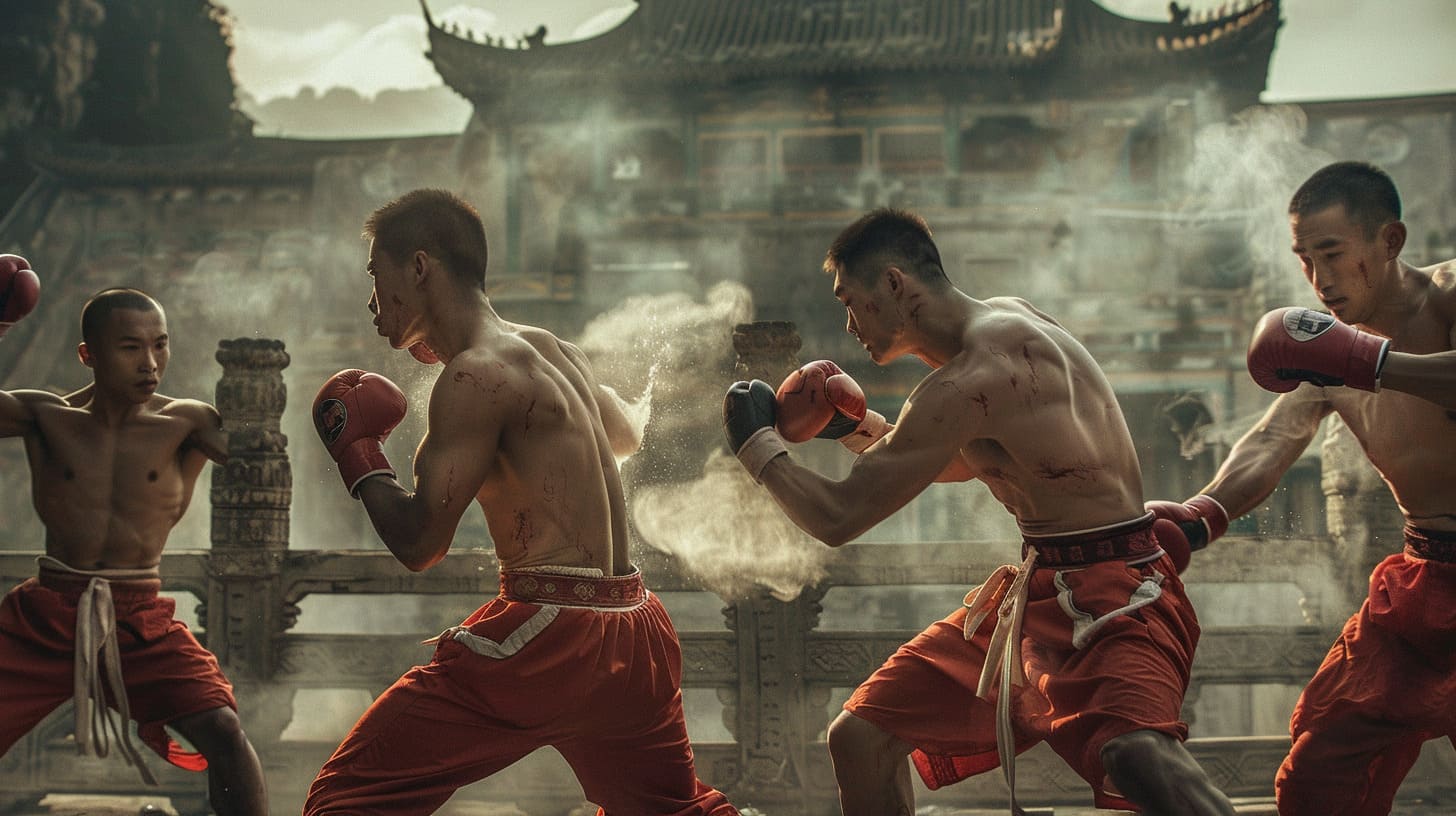
Getting into the groove of Chinese boxing requires not just an understanding of its philosophy and techniques, but also a focused training and conditioning regimen that enhances your agility, speed, and strength. Now let’s dive into some specific ways you can sweat it out and gear up to master the Chinese boxing style.
Drills and Exercises
To truly adopt the Chinese boxing style, you’ll need to incorporate exercises that emphasize fluidity, reflexes, and precision. Here’s a look at some key drills and exercises to get you started:
- Shadow Boxing with a Twist: Engage in shadow boxing rounds, adding traditional Chinese boxing movements. Pay extra attention to your footwork, mimicking the smooth, gliding steps characteristic of the style.
- Bag Work for Precision: Use a heavy bag to practice your strikes. Rather than just punching, focus on accurate, swift strikes that mimic the hand techniques used in Chinese boxing.
- Reflex Training: Partner up and work on defensive drills. Have your partner throw slow, controlled punches or strikes at you, and practice deflecting them with the fluid arm movements typical of Chinese boxing defenses.
Strength and Conditioning
While technique is paramount, strength and conditioning can’t be sidelined. Here’s a quick list of workouts to help you build the right kind of strength for Chinese boxing:
- Bodyweight Exercises: Incorporate push-ups, pull-ups, and squats into your routine to build overall strength and endurance.
- Plyometrics: Implement jump squats and box jumps to improve the explosive power needed for dynamic strikes and quick evasions.
- Core Workouts: Strengthen your core with planks, Russian twists, and hanging leg raises. A solid core is essential for the rotational movements and balance that Chinese boxing demands.
Flexibility and Mobility
Flexibility is a significant aspect of Chinese boxing; it aids in performing wide-ranging motion techniques and helps prevent injuries. Therefore:
- Daily Stretching Routine: Incorporate a 10 to 15-minute stretching session before and after your workouts.
- Yoga or Tai Chi: Engage in disciplines that promote flexibility and mindfulness, which are beneficial in mastering the poised and calculated movements of Chinese boxing.
Additional Tips
To round off your training regimen, here are some additional strategic tips:
- Watch and Learn: Study footage of seasoned Chinese boxers. Observe their movements, stances, and how they transition between techniques.
- Breath Control: Practice breathing exercises to improve lung capacity and learn to control your breath during sparring, as it’s essential for endurance and composure.
- Mindset Training: Embrace the philosophical aspects of Chinese boxing; mindfulness and strategic thinking can give you an edge both in and out of the ring.
Remember, mastering the Chinese boxing style isn’t something that happens overnight. It requires dedication, consistency, and a passion for the sport. Incorporating these drills and exercises into your regular training, focusing on your conditioning, and adopting the additional tips will position you well on the path to excelling in Chinese boxing. Lace up those gloves, get in the zone, and remember — every master was once a beginner. Keep at it!
Final Thoughts
Wrapping up our deep dive into the multifaceted world of Chinese boxing styles, we’ve journeyed through the philosophical roots, explored the rich tapestry of techniques, and even took a stance on its challenges and defenses. From the powerful animal forms that influence the fighter’s arsenal to legends like Bruce Lee who immortalized the art on the global stage, Chinese boxing is a testament to martial sophistication and cultural magnitude.
Whether you’re looking to bolster your own fighting repertoire with graceful fluidity or to simply indulge in the storied traditions and philosophies, embracing Chinese boxing can be as enriching as it is empowering. If you’ve been inspired to pursue this captivating art, let these final words be the bell that rings in a new round in your martial arts journey. Seek out a dojo, engage with the community, and remember, the journey of a thousand miles in the ring begins with a single punch. Get out there and let your martial path unfold!
Additional Resources to Master Chinese Boxing Style
Hey there, martial arts enthusiasts! So you’ve sparked an interest in Chinese boxing, and you’re looking to dive deeper, right? Well, you’re in luck! Here’s a treasure trove of resources that’ll give you an insider’s view into the world of Chinese boxing. Whether you’re a beginner or looking to brush up on your skills, there’s something for everyone.
Books for a Deeper Dive
- “The Shaolin Workout” by Shi Yan Ming: A 28-day workout program that introduces Shaolin Kung Fu practices to improve strength, mental sharpness, and spiritual peace. Get it on Amazon.
- “Chinese Boxing: Masters and Methods” by Robert W. Smith: This classic provides valuable insights into the history and philosophy of Chinese boxing, including key techniques and stories from traditional masters. Find it here.
- “Tai Chi Chuan: Becoming One with the Tao” by Petra and Toyo Kobayashi: A book that delves into the Tai Chi form of Chinese boxing, exploring its health benefits and spiritual aspects. Snag your copy.
Explore with Articles
- “Exploring the Ancient Art of Chinese Boxing” on Martial Arts Planet: An enlightening article that discusses various aspects of Chinese boxing styles and their applications. Go to website.
- “The Evolution of Chinese Martial Arts” in Kung Fu Magazine: This thought-provoking read traces the history and development of Chinese martial arts, including boxing forms. Read the article.
Videos for Visual Learners
- “Discovering Chinese Boxing” on YouTube: A documentary-style channel with a series of videos exploring different styles, techniques, and the culture of Chinese boxing. Watch the videos.
- “Traditional Kung Fu” on Fight Tips: A detailed video breakdown of traditional Chinese boxing techniques and workouts for the modern martial artist. Check out the channel.
Websites for Enthusiasts
- Seven Star Praying Mantis Kung Fu: Offers extensive knowledge on the specific Chinese boxing style of Seven Star Praying Mantis, including technique tutorials and philosophies. Visit the site.
- Beijing Wushu Team HomePage: Dive deep into the world of Wushu, a modern performance and full-contact sport derived from traditional Chinese martial arts. Take a look.
Now that you’ve got a roadmap to becoming a Chinese boxing buff, it’s time to get reading, watching, and practicing. Remember, the journey of a thousand miles begins with a single punch (or page, or play button)! Keep training and stay curious — the world of Chinese boxing awaits you.
